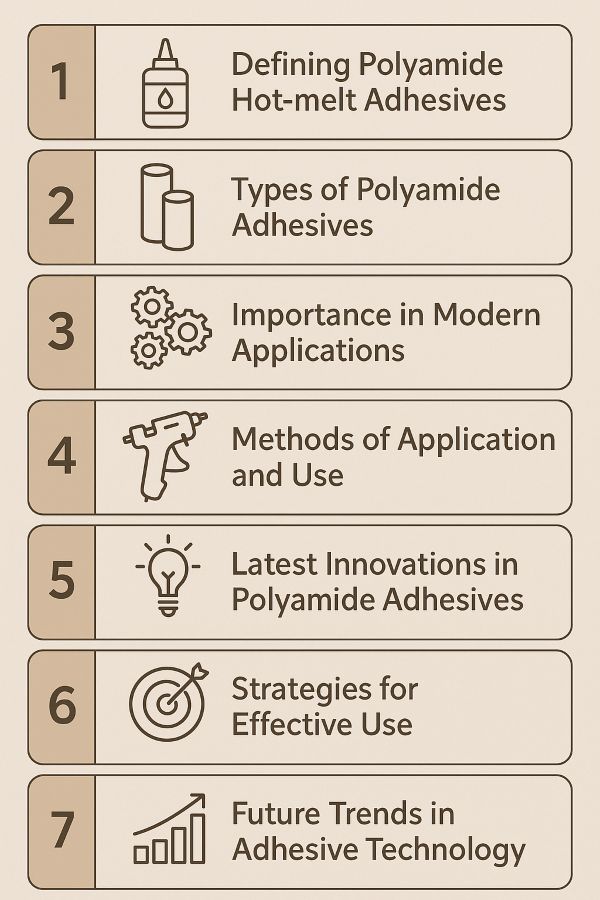
Defining Polyamide Hot-melt Adhesives
Importance in Modern Applications
Methods of Application and Use
Latest Innovations in Polyamide Adhesives
Strategies for Effective Use
Future Trends in Adhesive Technology
Frequently Asked Questions (FAQ)
Polyamide hot-melt adhesives have become essential in advanced industrial bonding due to their strong adhesion, chemical resistance, and thermal stability. Derived from polyamide resins, these adhesives offer versatility and durability, making them suitable for a wide range of applications such as automotive, textile, and electronics. Their fast setting times and high-performance characteristics enable efficient manufacturing and long-term reliability under challenging conditions.
Polyamide hot-melt adhesives are vital in modern industries where reliability and performance are non-negotiable. They are widely used in:
Automotive: Offering resistance to temperature changes and mechanical stress.
Textiles: Providing soft yet durable bonding.
Electronics: Ensuring encapsulation and insulation in compact components.
Their ability to enhance efficiency while meeting sustainability and safety standards makes them indispensable in current manufacturing processes.
To maximize performance, polyamide adhesives are applied through various techniques based on project scale and adhesive formulation:
Extrusion: Suitable for thick applications or structural bonding.
Spraying: Enables quick and uniform coverage in high-speed environments.
Roll coating: Used for continuous bonding on wide surfaces, especially in textiles or packaging.
Proper application method selection and process control ensure adhesive effectiveness and material integrity.
Recent advancements focus on improving the sustainability and versatility of polyamide adhesives:
Eco-friendly formulations: Designed to reduce VOCs and meet environmental regulations.
Enhanced thermal performance: For use in high-temperature environments.
Specialized functional additives: Such as fillers for heat conductivity or insulation.
These innovations aim to expand the usage of polyamide adhesives in sectors such as electric vehicles, green packaging, and flexible electronics.
To fully utilize polyamide hot-melt adhesives, the following strategies are recommended:
Select the appropriate adhesive based on chemical resistance, setting time, and operating temperature.
Ensure application tools are calibrated for uniform and efficient bonding.
Store adhesives under controlled conditions to maintain their shelf life and performance.
Regularly monitor process temperatures and substrate preparation to prevent bonding failure.
By integrating these strategies, manufacturers can ensure long-lasting adhesion and reduce production issues.
The adhesive industry is shifting toward greener, smarter, and more adaptable materials. Polyamide adhesives are expected to lead in:
Sustainable manufacturing: Through biodegradable and bio-based adhesive development.
High-tech applications: Supporting growing demand in EVs, wearables, and lightweight composites.
Regulatory compliance: With low-emission formulations that meet global environmental standards.
As demand for durable and eco-conscious materials rises, polyamide adhesives are poised to remain a cornerstone of industrial innovation.
What are polyamide hot-melt adhesives?
They are high-performance adhesives made from polyamide resins, used in industrial applications for their strength, flexibility, and resistance to heat and chemicals.
Why are they important in today’s industries?
They support efficient, reliable bonding in challenging environments—critical in sectors like automotive, textiles, and electronics.
How are they applied?
They can be applied via extrusion, roll coating, or spraying, depending on the production speed and surface area.
What innovations are emerging in this field?
Recent developments include eco-friendly, thermally enhanced, and function-specific variants that align with industry trends toward sustainability and advanced functionality.
How can I use them effectively?
By selecting the right adhesive type, maintaining application equipment, and monitoring environmental conditions, users can ensure optimal bonding.
What’s next for polyamide adhesives?
Future trends include bio-based compositions, low-VOC alternatives, and expanded use in lightweight, heat-sensitive applications.
Which industries benefit most?
Automotive, electronics, textiles, and sustainable packaging industries benefit from the reliability and adaptability of polyamide hot-melt adhesives.